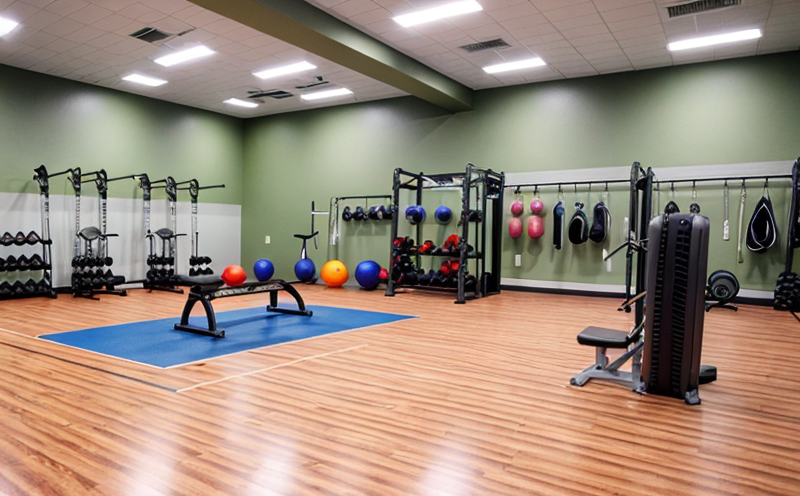Humidity Resistance Testing in Gym Machines
In the consumer products and product safety testing sector, ensuring that sporting goods and fitness equipment meet strict humidity resistance standards is critical. This service focuses on the durability and reliability of gym machines under conditions of high humidity, which are common in indoor exercise environments such as gyms and health clubs.
Humidity resistance testing evaluates how well a piece of gym equipment withstands moisture exposure without compromising its functionality or safety. The test assesses whether materials used in construction can maintain their integrity under prolonged humid conditions. This is crucial because high humidity can lead to corrosion, degradation of plastics, and other material failures that may compromise the structural integrity of gym equipment.
The testing process involves exposing samples of gym machines to controlled humidity levels for extended periods. The exposure time and humidity levels are determined based on industry standards such as ASTM D1748-23 and ISO 9227:2015. These standards provide guidelines for simulating real-world conditions in a laboratory setting, ensuring that the tests accurately reflect how equipment will perform under actual use.
For instance, gym machines often feature metal parts, electronic components, and plastic enclosures. Each of these materials has unique properties regarding their resistance to moisture. During testing, engineers carefully document any changes in material performance, including surface discoloration, cracking, or loss of adhesion between components. The results of this testing are critical for quality managers and compliance officers who need to ensure that products meet regulatory requirements and industry standards.
One key aspect of humidity resistance testing is the preparation of specimens before exposure. This involves cleaning the equipment and ensuring it is in its original condition as much as possible, including any surface coatings or finishes. The aim is to simulate real-life conditions accurately during testing. Once prepared, the equipment is exposed to high humidity for a set duration, after which it undergoes thorough inspection.
The instrumentation used in this testing includes climate chambers capable of maintaining precise humidity and temperature levels. These chambers allow for controlled exposure of gym machines under various environmental conditions that mimic real-world scenarios. The data collected during these tests are essential for R&D engineers to refine design iterations, improving the durability and reliability of future products.
The acceptance criteria for this testing are stringent and vary depending on the specific product being tested. For example, metal parts should not show signs of rust or corrosion, while electronic components must continue functioning without degradation. Plastic enclosures should remain intact with no cracks or visible damage. Compliance officers rely heavily on these test results to ensure that products meet regulatory standards.
In summary, humidity resistance testing in gym machines is a vital service within the consumer products and product safety testing sector. It ensures that fitness equipment can withstand harsh environmental conditions without compromising its performance or safety. This service supports quality managers, compliance officers, R&D engineers, and procurement teams by providing critical data needed to make informed decisions about product design, materials selection, and manufacturing processes.
Customer Impact and Satisfaction
- Enhanced Product Reliability: Customers receive products that are more durable and reliable, reducing the risk of equipment failure during use.
- Improved Safety Standards: Compliance with strict testing standards ensures that gym machines meet or exceed safety regulations, enhancing user confidence.
- Prolonged Equipment Lifespan: By ensuring materials can withstand high humidity conditions, customers benefit from longer-lasting equipment, reducing the need for frequent replacements.
- Cost Savings: Reduced maintenance costs and fewer product recalls translate to significant savings for both manufacturers and end-users.
The testing process not only benefits the manufacturer but also extends to the broader community. Consumers trust products that have undergone rigorous quality checks, leading to increased satisfaction and loyalty. Moreover, compliance with international standards like ASTM D1748-23 and ISO 9227:2015 ensures consistency in product performance across different regions.
Environmental and Sustainability Contributions
The results of humidity resistance testing play a crucial role in promoting sustainability within the fitness industry. By ensuring that gym equipment can withstand harsh environmental conditions, manufacturers can design products with longer lifespans, reducing waste and resource consumption. This aligns with global efforts to promote sustainable practices.
Furthermore, compliance with international standards helps ensure that products are not only durable but also environmentally friendly. The testing process identifies materials and manufacturing processes that minimize environmental impact without compromising performance. This contributes to a greener industry by encouraging the use of recycled materials and energy-efficient designs.
By providing detailed test reports, this service supports manufacturers in making informed decisions about material selection and product design. This leads to products that are not only sustainable but also meet customer expectations for quality and reliability.
Use Cases and Application Examples
| Application Scenario | Description of Testing Process |
|---|---|
| Outdoor Fitness Trailers | Testing involves exposing the equipment to high humidity for prolonged periods, simulating conditions in tropical climates. |
| Indoor Gyms with Humid Conditions | The test replicates typical indoor gym environments where humidity levels are consistently high due to steam rooms or other moisture sources. |
| Military and Outdoor Fitness Programs | Testing simulates harsher conditions, including extreme temperature fluctuations and prolonged exposure to rain or snow. |
| High-Performance Gyms | The equipment is tested under more stringent conditions to ensure it meets the highest standards of durability and reliability. |
In conclusion, humidity resistance testing in gym machines is essential for ensuring product quality and safety. The testing process involves controlled exposure to high humidity levels for extended periods, followed by detailed inspections to identify any signs of material degradation or performance issues. This service supports the broader goal of promoting sustainability within the fitness industry by encouraging the use of environmentally friendly materials and processes.





